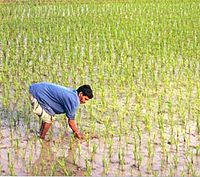
Green remediation of saline–sodic Pb-factored soil by growing salt-tolerant rice cultivar along with soil applied inorganic amendments
Sign Up to like & getrecommendations! Published in 2020 at "Paddy and Water Environment"
DOI: 10.1007/s10333-020-00807-6
Abstract: In Pb-factored soils, soil application of appropriate inorganic amendment along with cultivation of salt-tolerant crop species/genotypes for Pb immobilization can be a good choice. Hence, in saline-sodic and non-saline/sodic Pb-factored soils, Pb immobilization was observed… read more here.
Keywords: soil; inorganic amendments; rice; saline sodic ... See more keywords

Remediation of saline-sodic soil using organic and inorganic amendments: physical, chemical, and enzyme activity properties
Sign Up to like & getrecommendations! Published in 2019 at "Journal of Soils and Sediments"
DOI: 10.1007/s11368-019-02510-4
Abstract: Purpose Crops grow poorly in saline-sodic soils, and the productivity of these soils can be dramatically improved with proper amendments. Current research mainly focuses on either organic or inorganic soil amendments, whereas few studies address… read more here.
Keywords: organic inorganic; sodic soil; soil; inorganic amendments ... See more keywords

Water availability drives the effectiveness of inorganic amendments to increase plant growth and substrate quality
Sign Up to like & getrecommendations! Published in 2019 at "CATENA"
DOI: 10.1016/j.catena.2019.104116
Abstract: Abstract In a time when global climate variability threatens the sustainability and productivity of arid ecosystems, the development of effective strategies to recover and protect soil resources and biota is crucial for the survival of… read more here.
Keywords: plant growth; growth; inorganic amendments; increase plant ... See more keywords

Organic and inorganic amendments for the remediation of nickel contaminated soil and its improvement on Brassica napus growth and oxidative defense.
Sign Up to like & getrecommendations! Published in 2021 at "Journal of hazardous materials"
DOI: 10.1016/j.jhazmat.2021.125921
Abstract: In-situ stabilization has been considered an effective way to remediate metal contaminated soil. Thus, pot experiments were undertaken to investigate the effectiveness of multiple stabilization agents such as biochar (BC), mussel shell (MS), zeolite (ZE)… read more here.
Keywords: contaminated soil; growth; soil; inorganic amendments ... See more keywords

Biostimulation of Petroleum-Contaminated Soil Using Organic and Inorganic Amendments
Sign Up to like & getrecommendations! Published in 2023 at "Plants"
DOI: 10.3390/plants12030431
Abstract: The most common approaches for the in-situ bioremediation of contaminated sites worldwide are bioaugmentation and biostimulation. Biostimulation has often proved more effective for chronically contaminated sites. This study examined the effectiveness of optimized water hyacinth… read more here.
Keywords: water hyacinth; biostimulation; inorganic amendments; organic inorganic ... See more keywords